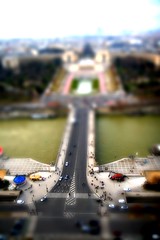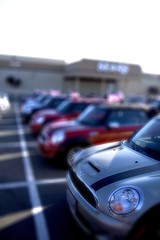Friday, January 27, 2012
I make a habit of signalling well before what I intend to do. We would all be a lot safer on the road if we were just a little bit more deliberate in our driving habits.
Thursday, January 26, 2012
Neither Snow nor Rain ...
"Neither snow nor rain nor heat nor gloom of night stays these couriers from the swift completion of their appointed rounds."
Of course we know this as the postal service creed. But, it's not. According to the USPS, they have no official creed. The reason this phrase has been associated with the postal service is because of an inscription on the collanade outside of the James Farley Post Office in New York City. The inscription was placed on the building by the firm of McKim, Mead & White, the architects who designed the Farley Building and the original Pennsylvania Station in the same Beaux-Arts style.
An interesting aside:
The original Pennsylvania Station stood directly opposite the James Farley Post Office building which was meant to match in strength the colonnade that originally faced it across 8th avenue. The original Pennsylvania Station was unfortunately demolished in 1963, much to the horror of many who opposed its destruction. The New York Times editorially lamented: "Until the first blow fell, no one was convinced that Penn Station really would be demolished, or that New York would permit this monumental act of vandalism against one of the largest and finest landmarks of its age of Roman elegance." ["Farewell to Penn Station". The New York Times. October 30, 1963. (The editorial goes on to say that “we will probably be judged not by the monuments we build but by those we have destroyed”).]
"Neither snow nor rain ..." is actually a borrowed phrase from Herodotus' Histories (Book 8, Ch. 98) and describes the faithful service of the Persian system of mounted postal messengers under Xerxes I of Persia. Wasn't that the Persian ruler who led the battle agaist the Spartans in the 300 movie?? The original phrase read:
"It is said that as many days as there are in the whole journey, so many are the men and horses that stand along the road, each horse and man at the interval of a day’s journey; and these are stayed neither by snow nor rain nor heat nor darkness from accomplishing their appointed course with all speed."
Portions of this post are borrowed from:
Sunday, January 22, 2012
Hadrian's Wall

Hadrian's Wall was built by the Romans around 120 AD, during the rule of emperor Hadrian. It was a time when the Roman Empire had ceased to expand and there was a general concern of maintaining existing lands. Some say that the wall was built to protect Rome from the barbarians, but other sources suggest that the northern peoples that remained, in what is now Scotland, presented little threat to the empire. The wall instead may have been built as a political display of might. It's possible that the wall was even covered in plaster and white washed so that it gleamed in the sun and could be seen for miles around (Anthony Everitt (2009) Hadrian and the Triumph of Rome, Random House).
The most heavily fortified border in the whole of the empire, the wall was 80 Roman miles long (about 73 statute miles) and extended west from Segedunum at Wallsend on the River Tyne to the shore of the Solway Firth - clear across, what is now England. In places, the wall measured roughly 10 feet wide and 10-20 feet tall - depending on construction materials available - and was buffeted on either side by berms and ditches. Definitely not as formidable as the Great Wall in China. Construction also called for 80 small gated milecastle fortlets, one placed every Roman mile, holding a few dozen troops each, and pairs of evenly spaced intermediate turrets used for observation and signaling.
A significant portion of the wall still exists, particularly the mid-section, and for much of its length the wall can be followed on foot by Hadrian's Wall Path.
More information can be found on Wikipedia.
Thursday, January 19, 2012
Miniature Paris
Wednesday, January 18, 2012
What Holds Clouds in Place?
The Awesomeness of LIDAR
 I am regularly asked what I do for a living. This is a difficult question to answer. I spend a lot of time in front of a computer manipulating digital data into a custom product. That final product, as well as the data collection is defined by the client. The client knows what their goal is and so defines what technology would best be suited to achieving that goal. Usually, a salesperson is involved in the decision about what technology should be used for collection as they are aware of our capabilities and the type of products that we provide.
I am regularly asked what I do for a living. This is a difficult question to answer. I spend a lot of time in front of a computer manipulating digital data into a custom product. That final product, as well as the data collection is defined by the client. The client knows what their goal is and so defines what technology would best be suited to achieving that goal. Usually, a salesperson is involved in the decision about what technology should be used for collection as they are aware of our capabilities and the type of products that we provide.  This final photo is a combination of the color shaded relief and the intensity image above. This image allows you to see the heights of features as well as the detail of other surrounding features.
This final photo is a combination of the color shaded relief and the intensity image above. This image allows you to see the heights of features as well as the detail of other surrounding features. Tuesday, January 17, 2012
Toy Car
Friday, January 13, 2012
Foliage
The word is foliage people
Not foilage
Get it right.
Isn't that some pretty foliage?? I like it a lot.
Quality of Life vs Insurance Company Meddling
Recently I changed medical insurance companies from Blue Cross Blue Shield (my company's insurance plan) to Aetna (my wife's company's insurance plan). There were a variety of reasons for the switch, but one of the biggest impacts recently - something that I did not anticipate - was a denial of prescription.
I take a daily dose of Ritalin LA for a minor case of ADD. I've been taking 30mg daily for more than 5 years. Under the new plan, the insurance company suggested to the pharmacy that they should fill the order with Vyvanse rather than Ritalin. I think the problem might be cost and the insurance company does not want to pay it.
Lisdexamphetamine (Vyvanse)
But here's the thing ... Vyvanse is a different compound. I have serious qualms about switching compounds just because an insurance company doesn't want to pay for another one. Don't get me wrong, Vyvanse might work wonderfully, and maybe even better than Ritalin. Under different circumstances, I might even be willing to try it, but not when I am fresh out of my regular meds. Perhaps, I should have planned ahead more, though I have never had an issue getting it filled. What about quality of life? The insurance company is not my doctor - they're not going to be the ones I call when something is not working right. What if something goes drastically wrong? As far as I am concerned, I would want some supervision before I go changing compounds.
The pharmacy suggested that I have my doctor call the insurance company and tell them that I will only take Ritalin LA and that should do the trick. So I left it in the doctor's hands this morning. I am going into my third day without taking it. Not a big deal, people (especially kids) usually take weekends off, but if it goes much longer, I will start to experience withdrawal symptoms. Hopefully, this is resolved quickly.
Update: I got a new prescription this afternoon from my doctor, but this time she wrote it for Vyvanse, instead of Ritalin! Another receptionist said that she heard the industry was running out of Ritalin. But my pharmacy said they had the Ritalin I needed, it was the insurance company that was refusing to pay. I guess I need more information so I can make an informed decision, so ... I made an appointment for tomorrow to discuss the issue with my doctor. Here's a link to a recent article about the shortage of ADHD drugs: http://www.nytimes.com/2012/01/01/health/policy/fda-is-finding-attention-drugs-in-short-supply.html?_r=2&pagewanted=1
Update (Jan 10): I talked to the doctor this morning about options, given that my regular Ritalin meds are not available. We discussed several alternatives to Ritalin and settled on Concerta. Concerta is a methylphenidate - the same compound as Ritalin - but, due it being a different manufacturer, it has different release times associated with its extended release qualities - 22% immediate and remaining 78% over 10-12 hours. For the record Ritalin was 50% immediate and another 50% after 4 hours. Our decision to go with Concerta is an attempt to minimize the impact to my system and the withdrawal symptoms that I am already beginning to experience from stopping the Ritalin - going into my 4th day off. I am going to monitor this very closely as I am pretty nervous about changing it in the first place.
Update (Jan 11): Trouble sleeping last night. It may have been anxiety or it may have been that I took my first dose of the Concerta at 11am (kinda late in the day) yesterday. Maybe tonight will be better. I am able to focus more on my work today than yesterday. Maybe this will work out after all.
Update (Jan13): Ok. I am now on my fourth dose of Concerta. The release times have been difficult to adjust to, but I think my system is sorting it out. The 1st and 2nd days were pretty rough. This type of drug is a difficult thing to monitor because it is adjusting a brain chemistry that is "not quite right" to begin with, by buffering connections between synapses and neurons. As such, the affects of the drug are difficult to sense. But, I believe I was having an issue about 4 hours after taking the medication because my body was expecting that 50% Ritalin hit and all it was getting was a small portion of the 78% remaining from the Concerta. It left me with a lot of up and down emotional swings. I figured I would give it a week and if I was still feeling the same, I would go back to the doctor.
Wednesday, January 11, 2012
TOS
For those in the know you probably know that the acronym TOS stands for "The Original Series" of Star Trek. You know, the one with Kirk, Spock and Bones. Pam is a die hard TOS fan. In fact, she loves it so much that she doesn't acknowledge the other Star Trek (The Next Generation, Deep Space Nine & Voyager) series' validity. Well, that may be a little harsh, but she does like TOS a whole lot more than those other imposters.
I was thinking today about the grammatical use of The Original Series acronym. Since the "T" is for "The", how does it work when one says something like:
"Pam is a huge fan of the TOS series of Star Trek."
Would that be correct? If we are to rewrite that phrase without the acronym, it would read:
"Pam is a huge fan of the The Original Series series of Star Trek."
Well, that's not right. Too many repeated words.
Perhaps one could say:
"Pam is a huge fan of TOS." and be done with it.
Personally, I believe the following should be true:
- An acronym should not contain a "The" at the beginning of the acronym. Too confusing.
- Use of an acronym should not include having to decipher it in order to use it grammatically correct in a sentence. Too annoying.
Thursday, January 5, 2012
Cat Food
Tuesday, January 3, 2012
Piping Hot
He woweth hire by meenes and brocage,
And swoor he wolde been hir owene page;
He syngeth, brokkynge as a nyghtyngale;
He sente hire pyment, meeth, and spiced ale,
And wafres, pipyng hoot out of the gleede;
And, for she was of town, he profred meede;″











